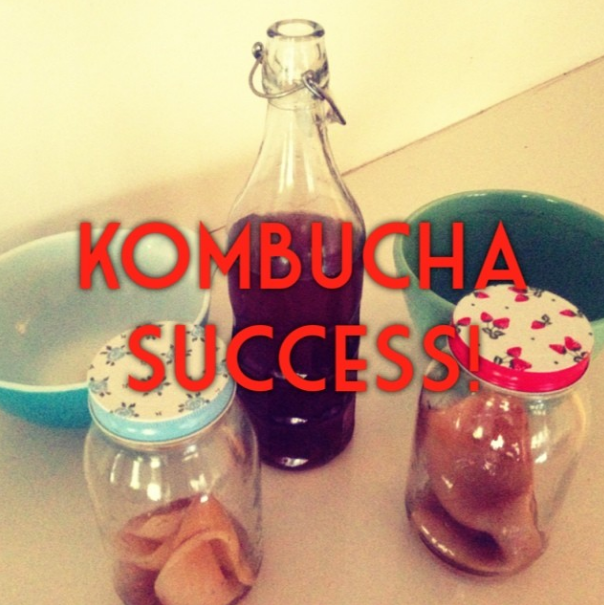When I was a kid my brother Ben used to grow mushrooms and raise axolotls in his bedroom (in and around my brother Pete’s feral mess and a pile of skateboards and BMX bits). I now realise these carefully reared mushrooms were kombucha “SCOBYs” and that his pre-pubescent experiments were quite ahead of the times. Ben was like that.

Before this all gets too weird for the unfamiliar, I’ll point out that kombucha is my latest fermenting experiment. You can catch up on some of my others here and here. And learn about why you should ferment here. Kombucha is a slightly fizzy fermented tea-based beverage. And a SCOBY (AKA a “symbiotic culture of bacteria and yeast”), or “mother”, is the starter mushroom that activates and propels the drink (by eating sugar…yes sugar!!) to become an “alive” gut-healing beverage.
In this post I’m going to cover some basics for making your first batch at home in the simplest way possible (and it is DEAD SIMPLE).
Why drink kombucha
The stuff is brimful of probiotics and is stand-out stuff for digestive health, assisting with nutrient assimilation. I won’t go into great detail here on the other benefits (iquitsugar.com will be covering this shortly), but studies have shown it can assist in the treatment of arthritis, depression, and heart burn, is great for liver detoxification, improves pancreas function, increases energy and can be used to treat Candida.
How to drink kombucha
Straight from the fridge. About 100ml (1/3 of a glass) a coupla times a day. First thing in the morning before breakfast is fab (I have some before heading off for exercise…beautifully energising), so is after dinner as something of a digestive chaser. I like to team it with a dash of soda/seltzer for extra fizz.
The deal with the SCOBY
These things are ugly as sin – rubbery and spongy, floating at the top of your concoction, with brown stringy bits dangling off it. They’re the “mother” culture and feed off the sugar, creating fermentation and a bunch of wonderful bacteria to boot.
How to Get a SCOBY?
Here’s the thing: you can’t make one from scratch or buy at a shop – you have to get “gifted” one.
Which just cracks me up. SCOBY swapping has become the stuff of impassioned online forums around the world. When I shared my first SCOBY it felt like I was dealing drugs in the school yard, albeit with a wholesome smugness to it. Seriously, when you share your first one (which you can do after making your first batch) I bet you get a righteous thrill from it!
1. From someone you know who already brews Kombucha. SCOBYs have a “baby” (this just gets better, doesn’t it!) every batch or two and can be peeled off, placed in a jar with some of the drink and lovingly passed on.
2. Online. In the US Cultures for Health is a good source. In Australia, try your local health good store or eBay!
3. Spawn one from a pre-made kombucha, like Remedy Kombucha. I go into this below.
How much sugar is in kombucha?
Yep, it’s made with sugar, but it’s the sugar that ferments…it largely disappears and ideally you’re left with 1 per cent sugar. In a 100ml serve, that’s about 1/4 of teaspoon of sugar, or 1/8 teaspoon of fructose.
Below I’ve used a ratio of 50g (1/4 cup) per 1 litre, but I’m currently experimenting with using less and using rice malt syrup instead and will report back.
Bear in mind: most recipes call for a bit more sugar than the recipe I’m sharing.
I spoke to Emmet, the creator at Remedy about quantities and he agrees 1/4 cup is about right to achieve a 1 per cent sugar content (which his product is). He also said this: “The sugar in the brew is eaten up pretty quickly so I would suggest a taste test after around day 4 or 5 at which stage the brew will be still be slightly sweet but with a good hint of tartness. To get down to under 10g of sugar per litre (i.e. 1%) the brew should be left until around day 7 to 10 (based on an average temperature of 24 degrees).
Does it contain alcohol?
A little is produced as a by-product of the fermentation process. But because the fermenting is done in broad bowls or jars, covered with a piece of muslin or a towel only, most of it evaporates. Most ‘bucha winds up around 1 per cent booze.
Bear in mind though: if you don’t refrigerate your ‘bucha after the fermentation period, the alcohol content will increase beyond 1 per cent.
Below are a bunch of other tips you might like to run your eye over before embarking…but for the impatient, the recipe (which I’ve based on one Kate at The Holistic Nutritionist shared with me; she also gave me my first SCOBY):
Almost Sugar-free Kombucha
- 1 litre pure, filtered water (note: most recipes advise not using tap as the chlorine can kill the SCOBY. I personally use tap and have not had issues.)
- ¼ cup organic sugar (normal or raw is fine)
- 2 organic black tea bags (many say non-organic tea just doesn’t work as well)
- ½ cup pre-made kombucha (from a previous batch or a commercial one in a bottle…see below)
- 1 SCOBY
Bring water and sugar to a boil in a medium saucepan. Remove from heat, add tea bags, cover and allow to steep for 15 minutes. Remove tea bags and allow liquid to cool to around body temperature. Pour into a glass or ceramic container (which you’ve sterilised with boiling water).
The container needs to be broad (not a narrow jar) to allow plenty of contact with oxygen. I use a ceramic mixing bowl.
Add pre-made kombucha (the liquid needs to be quite cool so you don’t kill bacteria) and then gently place the SCOBY on top (it may sink to bottom, this is OK, says my mate Kate). Cover the container with a towel or muslin. I use a sports towel and secure it with an elastic band. You can use a clean tea towel with pegs…or…be creative!).
Allow to sit for 7-10 days (7 will be plenty in warm weather).
The temperature needs to be around 24C…if it’s cool where you live, stick the bowl on the top of the fridge.
At the end of 7-10 days, a “baby” SCOBY will have formed on top of the liquid, the mother underneath. Remove both SCOBYs and store them in a glass container with a little kombucha. Or use one to start a new batch straight away.
Pour the kombucha liquid into a glass jar or bottle and refrigerate.
Some creepy SCOBY questions answered:
* It’s not unusual for the SCOBY to float at the top, bottom, or even sideways.
* The new SCOBY might cling to the mother or separate.
* The brown stringy bits floating beneath the SCOBY? All good. Some people strain. I don’t.
* It might be a little fizzy, a lot or not at all.
* Don’t wash any of your equipment with soap. Soap will kill the bacteria and yeasts in the SCOBY and will render it useless. Sterilise instead with boiling water.
• Avoid prolonged contact with metal…cooking the solution in a pot is fine, but don’t ferment or store it in a metal container.
• If your brew starts to smell cheesy or rotten or really vile, something has gone wrong. BUT!! If there’s no signs of mould on the SCOBY itself, chuck out the liquid but keep the SCOBY and start again. If you do see signs of mould, chuck the SCOBY too.
• A SCOBY can last for months, but if it becomes black, it’s a sign it’s ready for retirement. Put it to rest.
How to make a SCOBY from a bottle of kombucha
If you can’t find a gifter, buy a bottle of the stuff from a health food store. Ensure it hasn’t been pasteurised, filtered or chemically treated, contains no more than 1 per cent sugar and isn’t from overseas.
Emmet from Remedy Kombucha explains: All you need to do is make your brew as per above using one 330ml bottle of our original kombuchas (not the flavoured versions) as the feeder. Use a 3L jar as a minimum because kombucha can struggle in small containers. (Work on a total volume – including feeder – of about 2.5L as you don’t want to fill the jar right to the top.) Base your tea and sugar quantities on the full brew size including feeder. A SCOBY will start to develop over a couple of days, and get stronger as it goes. You might need to make a few batches before the SCOBY gets to full strength. Alternatively, you can also make a SCOBY by pouring a bottle or two of our original kombucha into an open-mouthed container, cover and then leave for three to four days in a warm room (i.e. around 24 degrees).
Any further questions? Any tips you want to share? Please do…this ‘bucha making caper is such a lovely communal thing.

